-
Welcome to rpgcodex.net, a site dedicated to discussing computer based role-playing games in a free and open fashion. We're less strict than other forums, but please refer to the rules.
"This message is awaiting moderator approval": All new users must pass through our moderation queue before they will be able to post normally. Until your account has "passed" your posts will only be visible to yourself (and moderators) until they are approved. Give us a week to get around to approving / deleting / ignoring your mundane opinion on crap before hassling us about it. Once you have passed the moderation period (think of it as a test), you will be able to post normally, just like all the other retards.
You are using an out of date browser. It may not display this or other websites correctly.
You should upgrade or use an alternative browser.
You should upgrade or use an alternative browser.
Burden of Command - WW2 tactical leadership RPG
- Thread starter Taka-Haradin puolipeikko
- Start date
-
- Tags
- ww2 is sooo-o passe
- Joined
- Apr 24, 2015
- Messages
- 19,231




https://www.rockpapershotgun.com/2018/08/24/the-flare-path-no-place-for-cowards/
al white lies while walking me through the WIP combat mechanisms at the heart of this recent ‘tactical teaser’ video:
– – – – Shock Attacks – – – –

Luke: Did you notice that when the StuG appears the GIs immediately show some suppression (Reduction of their morale attribute reducing their effectiveness as their heads go down. It may lead to either panic or ignored orders) despite that fact that no shots were fired. We call this a “shock attack”. Brains and Bullets (also titled War Games: The Psychology of Combat) calls it “weapon push”. The idea is that it is demoralizing to know the other side has weapons you can’t currently match. Here your GIs don’t have armor and the Germans do. Result: suppression. I’ve been told something similar happens when a dragon shows up in Total War: Warhammer! Except for GIs it was for real. Sobering.
There’s a nice example of how the Brits got wise to explicitly using shock attacks in WWII in Brains and Bullets. Trooper Brooks, a British soldier, describing the advance into Germany in 1945:
“Before anybody got in range, the Crocodiles would fire off a few jets of flame to let Jerry know what was coming and then they’d walk with the infantry up to the edge of town. Meantime Jerry was having a quick chat about their prospects, and ten-to-one they’d be waving bed sheets before the Crocs got in range. … Didn’t matter who they were: SS, paratroops, it didn’t matter. Once they’d had the carrot and the stick waved at them, they packed it in. Then we’d all have a brew and a fag before heading off to round up the next lot.”
This kind of morale shock from a mismatch in weaponry has been going on a long time. A quote from the fine WWI treatise Battle Leadership by Captain Adolf Von Schell (later a Panzer Division commander in WWII) who gave talks to the USMC between the wars:
“[WWI: 1916] The Russians had been firing for hours, but our artillery didn’t reply. I went constantly from dugout to dugout to see and speak to my men. They should at least see that they were not alone. Repeatedly they asked me: “Are we really entirely alone here; haven’t we any artillery?” It continued this way for hours. Our telephone wires had been shot to pieces. Finally a tremendous noise came from our rear. Our own artillery was firing. At once high spirits returned.”
But wait, don’t get too hopeful! We’re not going to hand you a lot of flame tanks or you’ll just wipe the floor with our scenarios. The Cottonbalers mostly didn’t have armor support.
– – – – Press and Stress – – – –

Lieutenant Wilson’s squad is “spent”, that is, they have already been ordered for the turn and can’t be given further actions. But now Wilson has a crisis on his hands with a larger German assault heading his way. He responds by “pressing” a squad of his company to give them another action so they can get to cover. But the side effect is long term stress. To be frank, this is a bit Hollywood. Stress psychologically and neurophysiologically comes from continued exposure to threats, especially threats you can do little about). Also from traumatic events like casualties of friends. In the military world we recognize it in its advanced form as shell shock (WWI), combat fatigue (WWII), or PTSD (today). Whether “pressing” stresses… who knows, but it is thematic and puts the player in the position of trading off short term benefit (get the hell out of there) vs long term (stressing troops). We always prioritize a good gameplay experience (otherwise just go read a book!) but we also try not to break history. So stress will be an important part of managing your men. They will accumulate stress mostly from simply being under fire or seeing casualties, but “press” will also generate it directly.
In WWII the US army realized that given enough exposure to combat everyone eventually broke. Unfortunately, for manpower shortage reasons they felt they could typically not rotate infantrymen out of the line (Germans did manage this more BTW). Though they would try to put them on quieter fronts to recover (Ardennes 1944 anyone?). The take away for you in Burden of Command is given enough time and enough exposure of your best officers and squads to combat you will find you have to manage their stress across the campaign (Darkest Dungeon led the way here as well as Dan Verssen’s leadership board games). You didn’t think using the best and brightest all the time would come free did you?
The gameplay effect of stress will be that stressed leaders and squads are brittle. They will overreact to threats. Incoming fire that might suppress only two points out of an average 10 morale unit might suppress a stressed unit four points. So experienced but stressed squads and officers become glass cannons requiring careful management. Do it enough and your Lts may ultimately break within the narrative. You have been warned!
– – – – Bolster and Assault – – – –

Lt Thompson is going to lead an assault. He needs to do a short-term pump of their morale (“Follow me!”) to increase the odds that they’ll follow. In gameplay terms “bolster” pumps morale but only for one action. Contrast a “rally” (remember Lt Dearborn facing the German armor?) which achieves a long-term morale boost at the cost of using up the rallied squad for the turn.
Leaders like Dearborn add human drama to combat but really were they that important? The short answer is “very.” One statistical analysis suggests that of their own volition a squad will perhaps assault 20% of the time. After all, who wants to fight hand to hand? In WWI they called it “fear of the bayonet.” A highly trusted leader, whether NCO or officer, can raise this chance to as much as 70%. In game terms, if you order a squad to assault without a “bolster” there’s a fair chance that the men “won’t quite hear you”. But should you lead by example they’ll likely follow.

Why are Lts doing all the key bolstering when truly it was the NCOs (Corporals, Sergeants etc) who were the Morale backbone? Here we have to plead Hollywood (i.e. game design) again. We focus on key officers to reduce the number of dials you have to turn. We do this not only for simplicity but to increase the chances you’ll empathize with the small band of NPCs who are your “direct reports”.
Some beautiful examples of leadership courage can be found in John McManus’s account of the fighting at Omaha Beach (The Dead and Those About to Die). Beautiful at a distance, but in practice the casualty rates among US junior officers in WWII were shockingly high. “Follow me” comes at a high personal price, a fact reflected in Burden of Command with permadeath.
– – Heroic but Green (or Failing to Obey the Four Fs) – –
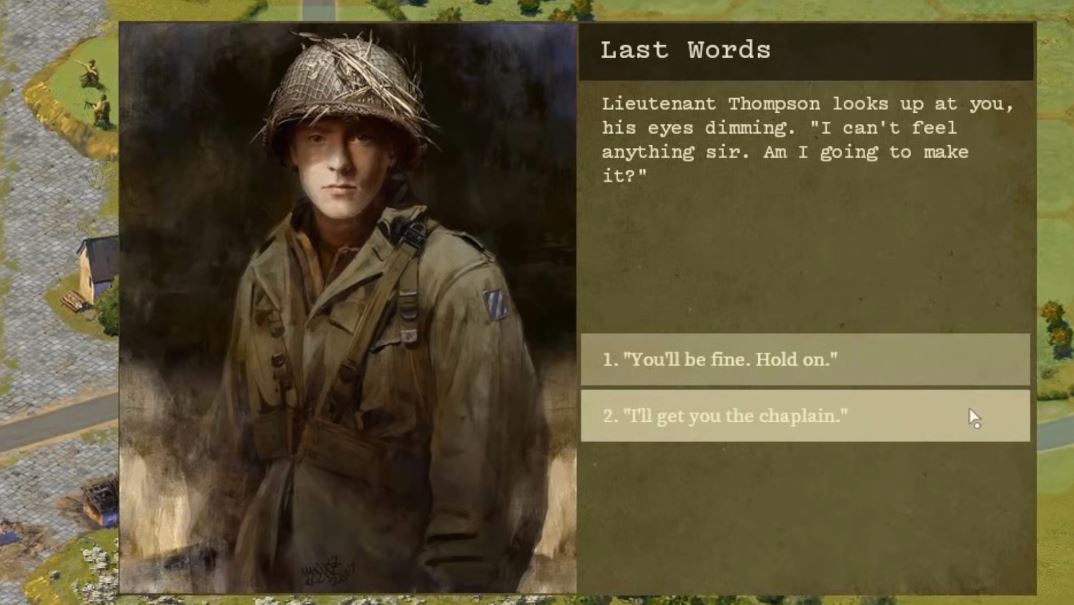
There’s a lot to admire in the personal courage of Lt Thompson leading the direct assault on the unsuppressed German MG. Less admirable is the standard of tactical leadership on show. There’s a reason Thompson dies at the end. Assaulting unsuppressed MGs, or even an unsuppressed enemy infantry squad, is an excellent way to perish quickly. In Burden of Command if you lead your men across open ground against an unsuppressed MG you will probably have a short career, your men will likely take very high casualties, and the assault will probably fail. Maybe to get this across in the teaser we should have had exactly that happen. But perhaps that would have been a little too much of a downer for a teaser. Ah hindsight, who can say?
So what should Lt Thompson have done? We couldn’t really give a primer on the “4Fs” in a two-minute video but, for future refrence, it’s: Find, Fix, Flank, and Finish. Specifically, Thompson should have first suppressed (“Fixed”) the German MG with both rifle fire and, assuming they were available, friendly MGs and mortar. After fixing he should then have flanked. Anyone interested in military history knows how important flanking is. Brains and Bullets views it as the single most powerful factor besides leadership and firepower. In Burden of Command terms if you are out of the front arc of the enemy unit when you arrive adjacent, not only will the foe not return fire, but they will suffer a morale check which will likely lead to them surrendering. As an aside, actual hand to hand melees in WWII were relatively rare. That’s why the teaser showed a surrender. It’s so often about morale and not brute force. Fear of the bayonet.
– – – – What’s Missing? – – – –

Of course there are many critical elements of Burden of Command not shown in the teaser. Command Points, “Push Your Luck”, battlefield friction, combined arms tactics, the importance of cover and stance, how troops “habituate” to repeated fire… Perhaps the most important omission is Fog of War. We all know how unpleasant it is in any military game to stumble into a undetected unit. Burden of Command will be no different. FOW was very intense in WWII. GIs were often shocked by the absence of any visible enemy on the battlefield (while still being shot at). Still on the drawing board is whether there will be explicit scouting actions for squads or leaders. We definitely plan for more experienced units to develop a sixth sense (better spotting). Several of the combat experienced vets amongst our team and testers have emphasized that certain individuals really do develop this.
Thanks for letting me prattle on about a subject I am deeply fascinated by – namely, how people react under the deep stress of combat (go listen to some Hardcore History podcasts to hear some amazing real world combat stories). In closing, I want to re-emphasize that first and foremost we want Burden of Command to be an engaging game. We will bend realism and history where we must to achieve that. But we’ll try hard not to break it!
ushas
Savant
- Joined
- Jan 5, 2015
- Messages
- 550
Cool. Went to look at the community hud. some snippets from the faq:
I don't know, doesn't look they are gonna release 2018.
Edit - Oh, seems they are hoping for sometime in mid-2019, according to the pcgamer article
https://www.pcgamer.com/burden-of-c...s-to-capture-the-personal-experiences-of-war/
What Platforms will Burden of Command be released on?
Initially PC via Steam. If sales are good, we will consider other platforms in addition.
...BoC should eventually make it to GOG, but will only be on Steam initially.
When will Burden of Command be published?
When it’s done... right! But you can check out our roadmap...

Why is it turn based? Real combat isn’t!
We want you to have time to think about leadership since you probably haven’t been through several months of Officer Training School. That being said we have contemplated time limited decisions, such as in Telltale games. Tell us your feeling about that here in the Community!
How many Campaigns are there?
One full campaign: the Cottonbalers which will be about 18 scenarios with their connected interactive fiction. We plan on further DLCs if things go well. Tell us what campaign you’d want next!
I don't know, doesn't look they are gonna release 2018.
Edit - Oh, seems they are hoping for sometime in mid-2019, according to the pcgamer article
https://www.pcgamer.com/burden-of-c...s-to-capture-the-personal-experiences-of-war/
Burden of Command is a tactical RPG that aims to capture the personal experiences of war
By Andy Chalk August 17, 2018
The game follows the men of the US Army's 7th Infantry Regiment as they live through the horrors of World War Two.
Burden of Command looks like a strategy wargame: Maybe Panzer General, maybe Hearts of Iron 3, or maybe something in between. Developer Green Tree Games insists that it is not, however. They describe it as "Band of Brothers meets XCOM," a blend of RPG and tactics that's "infused with battlefield psychology, where every decision counts."
Tactical battles are an essential part of the game, and players will have to master morale, maneuvers, recovery, and other basic military mechanics in order to succeed. But the scale is small, and the personal experience of war is the overarching focus: You play an officer in the US Army's 7th Infantry Regiment—the Cottonbalers—and must lead your soldiers through the second half of World War Two.
In case there's any doubt about its story-driven bonafides, Chris Avellone and Alexis Kennedy are onboard as two of Burden of Command's "top brass advisors." Avellone is credited with guiding the developers "on creating empathy, memorable characters, and compelling narrative arcs," while Kennedy provided "deft critiques through the process [that] have made our prose land on target more often."
"Avellone and Kennedy gave us early design advice and playtested the early version of the narrative," Green Tree's marketing lead Davide Pessach told me.
"Our writers are doing an amazing job, especially in squeezing every single word they use for meaning and atmosphere," he said. "Tactics really come alive when you factor in personal stories, skills and mindsets of your officers and soldiers."
That's why the developers are doing their best to avoid making too many connections with the wargame genre: Because Burden of Command is a game about war, which is more of a distinct difference than it might sound like.
"[We're] not bogging down players with infinite details, but focusing on men, tactics and stories. Accessibility is not a problem for us because the philosophy is really different from wargames," Pessach said. "That's why we think our game is more in the ballpark of XCOM or Shadowrun—games that deliver accessibility with tutorials and tooltips instead of lengthy manuals."
Even so, there's a strong commitment to historical authenticity: Other advisors on the project include historian and author John C. McManus and award-winning novelist William Bernhardt, and playtesting is being headed up by Adam Dials, a US Army veteran of Iraq who now serves with the Texas National Guard.
"We aim to recreate the personal struggles of officers—their 'burden of command'," Pessache said. "So personalities, crises, painful decisions, shocks... Everything is factored in the mindsets of these officers in the tactical battles they lead."
Green Tree Games hopes to have Burden of Command out sometime in mid-2019, but that's not carved in stone: "The team is small and the effort is really a gargantuan one," as Pessach put it. For now, a development roadmap tracking the plans and progress is maintained on Steam, and you can learn more about the project at burdenofcommand.com.
By Andy Chalk August 17, 2018
The game follows the men of the US Army's 7th Infantry Regiment as they live through the horrors of World War Two.
Burden of Command looks like a strategy wargame: Maybe Panzer General, maybe Hearts of Iron 3, or maybe something in between. Developer Green Tree Games insists that it is not, however. They describe it as "Band of Brothers meets XCOM," a blend of RPG and tactics that's "infused with battlefield psychology, where every decision counts."
Tactical battles are an essential part of the game, and players will have to master morale, maneuvers, recovery, and other basic military mechanics in order to succeed. But the scale is small, and the personal experience of war is the overarching focus: You play an officer in the US Army's 7th Infantry Regiment—the Cottonbalers—and must lead your soldiers through the second half of World War Two.
In case there's any doubt about its story-driven bonafides, Chris Avellone and Alexis Kennedy are onboard as two of Burden of Command's "top brass advisors." Avellone is credited with guiding the developers "on creating empathy, memorable characters, and compelling narrative arcs," while Kennedy provided "deft critiques through the process [that] have made our prose land on target more often."
"Avellone and Kennedy gave us early design advice and playtested the early version of the narrative," Green Tree's marketing lead Davide Pessach told me.
"Our writers are doing an amazing job, especially in squeezing every single word they use for meaning and atmosphere," he said. "Tactics really come alive when you factor in personal stories, skills and mindsets of your officers and soldiers."
That's why the developers are doing their best to avoid making too many connections with the wargame genre: Because Burden of Command is a game about war, which is more of a distinct difference than it might sound like.
"[We're] not bogging down players with infinite details, but focusing on men, tactics and stories. Accessibility is not a problem for us because the philosophy is really different from wargames," Pessach said. "That's why we think our game is more in the ballpark of XCOM or Shadowrun—games that deliver accessibility with tutorials and tooltips instead of lengthy manuals."
Even so, there's a strong commitment to historical authenticity: Other advisors on the project include historian and author John C. McManus and award-winning novelist William Bernhardt, and playtesting is being headed up by Adam Dials, a US Army veteran of Iraq who now serves with the Texas National Guard.
"We aim to recreate the personal struggles of officers—their 'burden of command'," Pessache said. "So personalities, crises, painful decisions, shocks... Everything is factored in the mindsets of these officers in the tactical battles they lead."
Green Tree Games hopes to have Burden of Command out sometime in mid-2019, but that's not carved in stone: "The team is small and the effort is really a gargantuan one," as Pessach put it. For now, a development roadmap tracking the plans and progress is maintained on Steam, and you can learn more about the project at burdenofcommand.com.
Last edited:
Burning Bridges
Enviado de meu SM-G3502T usando Tapatalk
"Burden of Release" 
- Joined
- Apr 24, 2015
- Messages
- 19,231




You do know that you're physically incapable of humor, don't you?
Burning Bridges
Enviado de meu SM-G3502T usando Tapatalk
Ah the irony
ushas
Savant
- Joined
- Jan 5, 2015
- Messages
- 550
Hm, doesn't seem to be even explained why don't want advance. Though #2 looks a bit like persuasion.It's been bugging me that this example doesn't offer choice to trust your sergeants judgement (and have quiet word afterward even if his was the right call).http://burdenofcommand.com/mindsets-and-crucibles
Take the following example:

What would you choose?
This example is based on an actual event involving Lieutenant Ronald Speirs, of Band of Brothers fame. According to witnesses, Speirs shot his Sergeant in self-defense. Afterward, Speirs reported the incident to his commander, Captain Gross, who ruled the shooting justified after a short investigation (details here).
Like Speirs, combat will confront your officers with hard choices in Burden of Command. Some of these points will be scripted, while others will occur randomly or as a result of the player’s choices on the tactical map. We call these choices Crucibles, because they add or reinforce the Mindsets of the officer who goes through them, based on the choices you guide them into making. Over the course of multiple Crucibles, each officer will acquire a unique collection of Mindsets. These will shape both their leadership abilities in tactical battles, and their personal Journey as a character. In other words, your narrative decisions will explicitly craft your “character arc.”
Choices presented have all the same goal; "stop your unit advancing", only difference being in stat gain and risk calculation.
I really hope that game doesn't railroad you too much.
Perhaps there could have been a fork at that part "You bark the counter-order" already...
Something like
(a) Do nothing (will advance, big chance of casualties)
(b) giving him benefit of the doubt, eg. "Sergeant, explain yourself!";
(c) bark the counter-order...
At that later point, when you already barked clear counter-order and he deliberately rebelled, letting it be would look like saying "oh ok, don't mind me then".
Got bored and left
Guest
Hm, doesn't seem to be even explained why don't want advance. Though #2 looks a bit like persuasion.
I dunno, advancing into an ongoing artillery barrage doesn't sound like a terribly good idea.
Besides, this is just an example based on a historical event, we probably shouldn't read too much into it.
Last edited by a moderator:
- Joined
- Apr 24, 2015
- Messages
- 19,231




https://theplayersaid.com/2018/10/2...n-a-look-at-burden-of-command-by-luke-hughes/
Guest Blog: Tactical Board Games on Your Computer Screen – A Look at Burden of Command by Luke Hughes
Over the past few years, I have been following the Burden of Command Twitter handle and am really interested in what they are doing on it. Their Project Lead is Luke Hughes and I reached out to him a few weeks ago and asked if he’d be interested in telling us what Burden of Command is, how it works and what we have to look forward to. Luke has done a fantastic job with this Guest Post and I am pleased to be able to share it with our audience.
What if many of the design innovations in tactical board games could reach the computer screen in a new design? That’s Burden of Command.
In this guest blog, humble thanks to The Players’ Aid, I’ll introduce you to Burden of Command and its specific mechanics using the prism of board games. I have played historical board games since childhood starting with Avalon Hill’s Gettysburg and the original Squad Leader. It is of personal importance to me to draw on their great legacy, as well as their continuing creativity. I do not claim the games referenced here are the definitive ones, only that they were my most key influences.
Burden of Command puts you in the boots of a US infantry company Captain in World War II. With the advising and playtesting guidance of noted military historian John McManus, we follow the historic Cottonbalers through their duties from Morocco in 1942 to Hitler’s Eagle’s Nest in 1945.
You’ll lead not only on the battlefield but off in an extensive interactive fiction story campaign much like you might encounter in a class computer RPG (e.g., Baldur’s Gate, Shadowrun’s Return, The Banner Saga, etc.). Our intent is not only to have you grapple with some of the command realities the historic commanders had to experience (think of HBO’s Band of Brothers) but also to build your empathy for your men. Then, when you make tactical decisions on the battlefield, you pause to think personally about the lives of the men whom you are now putting at risk. In other words, you’ll feel the “burden of command.” Is it right sending Lt. Dearborn up the hill in ‘45 when he has served you loyally since ‘42? He’s more effective (though you do worry about his Stress)… but maybe that green Lt. Thompson should learn to carry his weight…but his inexperience risks the men… maybe…
You get the idea.
However, let’s start on the mechanics with the more familiar board game terrain of tactical battlefield leadership. John Hill’sSquad Leaderand its remarkably successful descendantAdvanced Squad Leaderfrom MultiMan Publishing, are the ‘ur’ inspiration for Burden of Command with their emphasis on small unit leadership. Leaders are key units (especially the 10-3’s !) acting to critically improve squad performance. As well as keep them from breaking under enemy fire due to “Morale Checks” (MCs).
Please watch this recent two minute tactical teaser, many design elements should be familiar from SL/ASL but you might notice some more modern aspects. And yes, Lt. Thompson behaves inadequately at the end in a way you never would
I hope you noticed that leadership actions expend Command Points (CPs). This modern euro “Limited Resources” mechanic is seen in more recent Conflict of Heroes (CoH) from Academy Games and Band of Brothers from Worthington Games. If you’ve played CoH you’ve agonized over how to spend them: “should I aid that critical attack?”… “revive that at risk spent unit?” In Burden of Command, these CPs are tied to your individual leaders on the battlefield, just like in Fields of Fire (FoF) by designer Ben Hull from GMT Games. This means each of your Lts faced his own personal command struggle as to where and how to allocate his precious CPs. Further, where you move your Lts with their limited CPs will be key, just like leader placement in SL, ASL and for that matter admirable Combat Commander (CC) from GMT Games and Chad Jensen.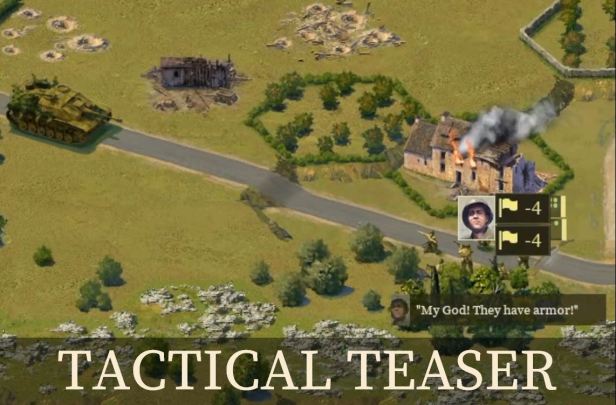
Chad went with a command range to define which units a leader controls. After some design tests in a digital context, Burden of Command opted to embed your leaders in a classic formal chain of command. So for example, a given Lt. like Dearborn commands a specific set of squads, namely first platoon. As Captain, and company commander, you can influence your Lts performance by directly assisting them or their squads with your own CPs. Where you put yourself on the battlefield may be pivotal. Not only is having a formal chain of command more analogous to real command, but in the design spirit of Burden of Command we hope you develop emotional attachments to specific platoons and their units, as they take casualties on your behalf, and as they develop battlefield Experience (XP), and Trust (a mechanic improving their Morale) for their Lieutenant. As a canny Captain you’ll come to know when and where you should and shouldn’t use Dearborn and his first platoon.
In summary, overall, leadership inBurden of Commandfeels most like:
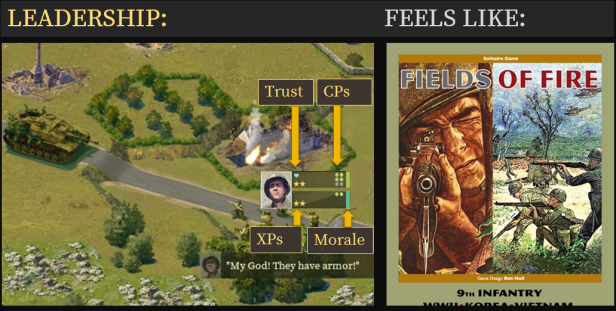
In most tactical games fire on a target produces MCs. A failed MC leads to a dysfunctional or “broken” unit. Repeated failed MCs lead to elimination. By contrast, Band of Brothers (BoB) by designer Jim Krohn from Worthington Games, takes the radically different view that firepower does not destroy units it only Suppresses them. Suppressed units are combat ineffective but will not typically surrender or otherwise be destroyed unless you cross the battlefield to engage in melee. In other words, BoB encourages you to apply the classic 4Fs: Fire, Fix, Flank, and Finish, rather than simply apply firepower. You can read a more elegant defense of this approach than I can muster in this essay by Jim.
For Krohn, MCs are not tests for destruction but tests of whether a unit will act. Suppressed units often don’t. In Burden of Command, we similarly use MCs to gate whether a unit can act rather than whether it will be destroyed. Your leadership focus will be to first cripple the opposition through Suppression and then flank (as Thompson should have in the teaser) and finally assault. You may choose to use your limited CPs(!) to improve the initial suppressive firepower or alternatively you might save them to lead the assault and help your men pass the critical assault MC (an especial test of men’s nerve). What will be your leadership style?
You can see a still frame sequence of such key MCs in the visual below. In the first frame, the assaulting Germans MC to see if they dare to cross to melee (MC: “Go Hand to Hand?”). They have just passed and have started to move out of the woods. In the next frame, Dearborn opens up with opportunity fire.. .the Germans are “Exposed” (high chance of casualties) but due to prior suppressive fire on Dearborn and his men, the OpFire is limited. The Germans pass the “Take Cover?” MC and press on. Now the moment of truth for Dearborn and his men, will they stand for hand to hand or flee?
A mini story in a nutshell, just like SL, ASL, CC, and BoB, but in this case with men you care about. In other words (pictures?):
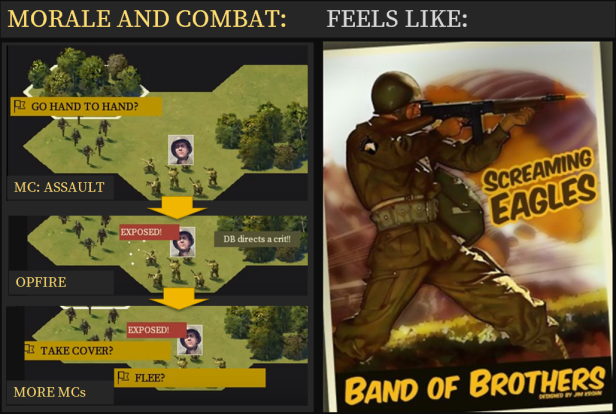
Anyone who reads history knows that battles large or small are full of chaos. The downside for the player is they are not always in control. The upside is that inevitably good stories are created (“remember that time my last unit was about to die… went Berserk under fire and then, Sgt. York like, crossed the open to…”).
Like SL/ASL and in particular like the masterful leadership and chaos engine known as Combat Commander (CC), Burden of Command will have a library of classic events (e.g., Jamming, Berserk, etc.) as well as one off historical ones engineered by our fiendish writers! And of course the inherently chaos generating MCs tied to critical actions, as illustrated above where the Germans might have folded and taken cover, or Dearborn might have fled.
Additionally, Burden of Command is throwing an especially leadership focused chaos into the mix: “Friction.” Friction is that inevitable wear and tear of chaos on the delivery, interpretation, and execution of orders. Mechanically, in Burden of Command this is realized by “dice rolls” at the start of each turn for each leader. A given leader may randomly lose CPs long term…gradually eroding their ability to control events…until they take the painful decision to stop and spend a full turn on Assess. Assess is a leadership action which restores full CPs. Think of it like a CP ‘Rally.’ But, of course, battles are hardly convenient times to stop and Assess. How will you and your Lts manage the battlefield tempo, Captain?
For these reasons in terms of Battlefield Chaos Burden of Command:
A relatively recent simple innovation in wargames in general is alternating impulses. Manifested more recently in tactical games in Academy Games Conflict of Heroes (CoH) series. Instead of moving all units on your side, or even a command group, single units are moved in alternation. This creates implicit chaos by providing the opposing player a frequent opportunity to mess with your best laid plans! No plan survives contact with the enemy! Burden of Command employs alternating impulses, though your leader’s experience might help you maintain command momentum for several impulses.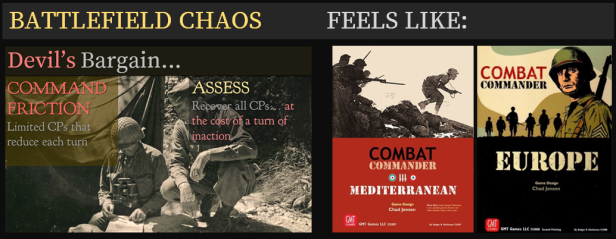
It’s worth stopping to mention at this point that all features for Burden of Command are subject to change based on playtesting feedback and of course my design whims
CoH also has a very recent innovation in cardboard chaos creation. Specifically, a “Push Your Luck” (PUL) mechanic around when units become “spent” (i.e., can’t do more actions). First pioneered in their Solo module and now a core mechanic in their third edition, players roll a die each time a unit takes an action. More difficult actions (e.g., moving a heavy machine gun) are more likely to make the unit “Spent,” easy actions (an infantry squad moves one hex on a road) less so. But the key is you never know when your unit will become spent. It might come in the middle of a field. It might come right after your beautiful suppressive fire when you could make that key sprint. You can spend CPs to improve your odds..but they are Oh So Limited! If you think battlefield leadership is in many ways about taking gambles, then this elegant PUL mechanism is a lovely chaos story creator, and arguably a good realism generator. Given our leadership design obsession this is a particularly appealing form of Command and Control (i.e. leadership) chaos. Burden of Command will implement similar PUL mechanisms.
Overall when considering battlefield chaos, Burden of Command feels not only like CC but also like CoH:
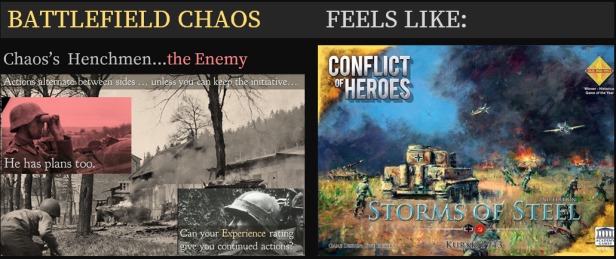
Compared to the vast majority of tactical military board games, and tactical military computer games (e.g., Steel Panthers, Close Combat, Combat Mission, etc.), Burden of Command is arguably most distinctive for being a leadership RPG. Through an extensive interactive fiction (IF) story based on their historical events of the actual Cottonbalers, as well as other events in the careers of other WWII small unit commanders, you will chart your own leadership journey. This two minute teaser gives you a taste, though the decisions are very laconic for purposes of video presentation:
If you want more on the RPG side and how we craft your spiritual, moral, and tactical leadership journey through mechanics of Crucibles and Mindsets see this dev blog.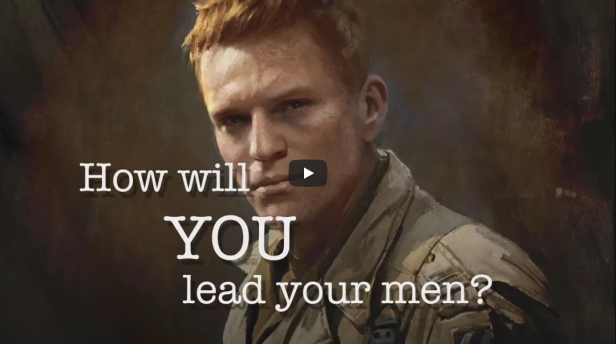
The arguable originator of providing a WWII tactical RPG experience was Ambush! by John Butterfield and Eric Lee Smith. As you moved across a tactical map events could trigger based on the hex you entered. Causing unexpected events (Chaos!), occasional choose your own adventure moments, and sometimes just atmosphere (an enemy meal left behind in haste in the building you enter). In Burden of Command a fairly sophisticated pattern matching engine — my background is in part AI — helps our writers trigger such events based on the hex you entered but also based on the actions you take (e.g., did one of your Lt’s just fail a key MC to assault? What might he or his men say or do?). In short, we provide a sophisticated scripting engine to create what we hope is a worthy descendant of Ambush!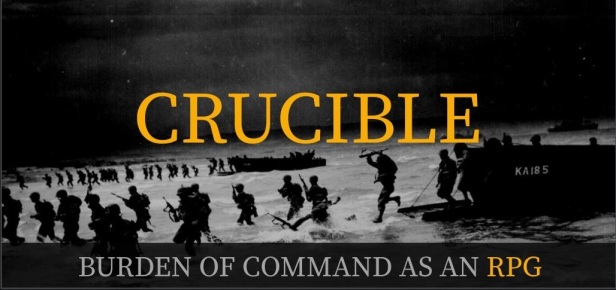
Visually:
Across the long campaign our writers Allen Gies and Paul Wang have worked hard not only to create empathy for the men whom you lead but also to immerse you in the historical experience of being in the US Army in WWII. Professor McManus has not only advised, but actively playtested the Interactive Fiction in support of this.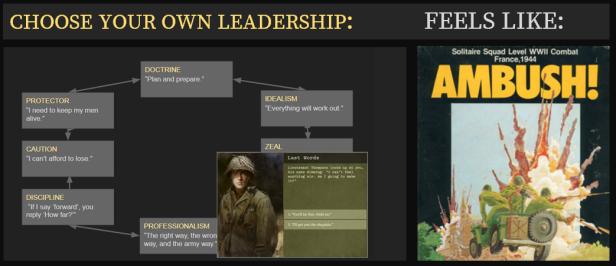
The long campaign will also have some light RPG management mechanics. For example, we plan on implementing Stress mechanisms as pioneered so finely by Dan Verssen of Dan Verssen Games in his leadership-games (e.g., Hornet Leader, Thunderbolt Apache Leader, etc.). But since these campaign mechanics are ill defined, perhaps The Players’ Aid will invite us back for a future guest blog!
Therefore, in terms of leading a company across an historical long war, Burden of Command feels like:
Before closing, it should be mentioned that one WIP board game that is sure to have an ongoing influence is: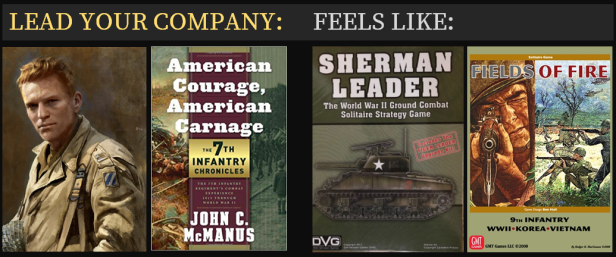
Due to its designer being our scenario lead Steven Overton (also of Combat Mission scenario design as “Mad Russian”! I told you we had a heavy board game influence). We’ll have more to say on FTRE when it’s out and you’ve had a chance to play too.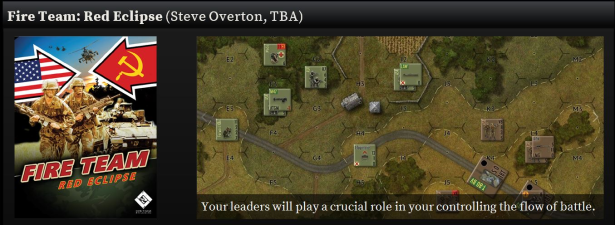
It’s been a pleasure having this opportunity to talk to the “tribe.” I hope the Grognards amongst you will forgive me my no doubt myriad mistakes, and I look forward to further discussing what are the most credible mechanisms for modeling battlefield psychology. Come chat at our Twitter account which I run (@BurdenOfCommand; or our analogous Facebook) and, please, if you want to help us along, Wishlist us on Steam. We’d love to do many more campaigns across many theaters and wars. Feel free to suggest some!
Burden of Command, a tactical leadership cRPG or, if you prefer, a hopeful child of a remarkable board game tradition.
-Luke
ushas
Savant
- Joined
- Jan 5, 2015
- Messages
- 550
https://www.thesixthaxis.com/2018/11/22/playing-with-history-dealing-with-the-burden-of-command/
Partly listened to the Single Malt interview some time ago. Few tidbits (sorry don't recall much):
The campaign (about Cottonbalers, will start in Morocco, then Sicily, further in Italy, southern France, and Germany at the end) is linear, no branching story on that level, but we can choose if/how we do scenarios, even can decide to lose them. Some minor random events. Think there are four lieutenants and the first sergeant who report to the player. It's not only them who can disobey orders, however, but also the squad under their command can have its own doubts (sounds like two layers of trust, perhaps something like squad -> lieutenant -> player?). They'd like to hear suggestions for other campaigns. Will choose some for a DLC (am guessing this will depend on sales).
Playing With History - Dealing With The Burden Of Command
Morals of War
by Adrian Burrows
Creating compelling and interesting moral choices in video games is particularly tricky, the evidence of which can be seen in more games than I can shake a stick at. Indeed, were I to actually try and shake a stick at all of them, I’d probably end up with forearms more muscular than a teenager who just discovered the seedier side of the internet. Too often the decisions in video games lack complexity, usually offering only two options to the player, ‘good’ and ‘bad’. Even then, there’s usually little motivation for choosing to be bad.
If you’re good, not only do you have a host of NPCs telling you how awesome you are thanks to your heroic virtue signalling, they’ll also give you lots of fantastic gifts. Undertaking bad actions on the other hand, just has the effect of making a lot of people want to kill you, often ensuring progression through the game is much more difficult. It’s morally simplistic and also a poor reflection of reality. After all, if doing bad things provided no benefit then why would anyone do them?
It’s refreshing then, that into the currently stagnant game mechanic of moral choices a new contender emerges; Burden of Command. Set in World War II, Burden of Command is a turn-based strategy game with the particularly interesting remit of creating a psychological battlefield. This means the game will focus on the themes of morale, stress, experience, trust and respect. I was particularly interested therefore, to have a chat with project lead, Luke Hughes. With A PHD in AI from Yale and a Masters in Neurophysiology and Psychology from Oxford, he’s clearly a rather clever chap and has many fascinating insights.
This being a Playing with History article, the first thing I asked Luke was if Burden of Command focuses on soldiers who really fought in WWII? ”We take a real regiment,” he replied, ”which is a fairly large unit, and we take a company of them of about a hundred men. Our company is fictional, but the regiment they are a part of is real, the Cottonbalers. It’s a regiment that I think has been through all the American Conflicts since 1812 and John McManus, a historian who playtests for us, wrote their history. So we follow their history really carefully. You go to the places they went, the battles they went to, deal with the things they dealt with. We take liberty to inject events that may or may not have happened to them, but typically happened in other places in the war or to other people. Our licence is authentic, but we draw from anywhere in WWII where relevant with a bias to the Cottonbalers.”

The player follows the exploits of the Cottonbalers through a series of conflicts in a turn-based, table top strategy format. Within this, the game tasks you with making difficult decisions to dynamic situations. It is these decisions that are intended to be psychologically intensive, to attempt to portray what it would have been like to make these choices under pressure in real life.
But spotting the right decision to make in a video game is easy, right? ”There’s no right choice, so what is right for your leadership style?” Luke responded, ”Let me give you an example; this is a historic one the Cottonbalers had to deal with. So, they’ve just taken this hill and this battalion of Germans – which is basically three times their size – appears and it’s pretty likely they’re going to get their asses kicked if they stay. What’s your responsibility? To stay and fight or withdraw? One of the problems is there’s some other Americans on your flank, so if you withdraw they’re going to take the pain rather than you. Or maybe your first responsibility is your men? Maybe your first responsibility is to the mission? What’s your style?”
”To boil it down, Burden of Command is man verses the mission. On the one hand, you can argue that your central moral responsibility is to serve the mission. I mean you want to beat the Nazis. Maybe you should always make the hard decisions and cost the lives of your men? Because in the end, it’s more important to win the war isn’t it? You can be a hard charging guy through the war, you’ll lead efficiently, but the men probably won’t trust you because they know you’re the butcher, you’re willing to get them killed for the mission. But maybe that’s still the right thing to do? Some generals are seen as butchers, but that doesn’t mean they weren’t good generals.”
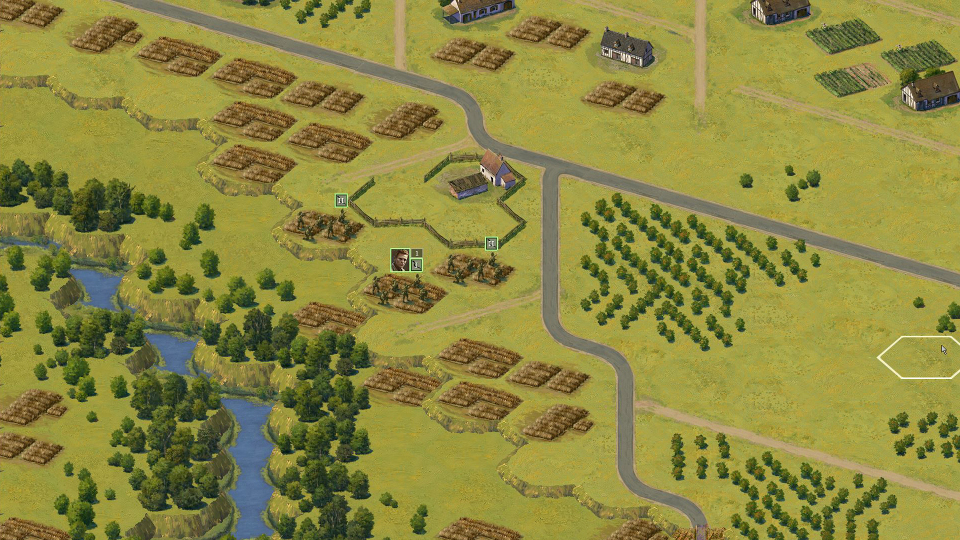
”Inversely, you might decide you need their trust, that you can’t be an effective leader without their trust. I can’t get them to follow me and assault when the time comes if they don’t trust me. Just for military tactical purposes maybe I will protect them because that’s a good leadership style. And finally, maybe I need to protect them because they’re other people. So, you tell me, what was the right decision there? Was it the guy who actually helped win the war? Maybe the ruthless guy saved more lives, but not those of his own men. Maybe the compassionate guy saved more of his men, but cost more lives during the war for other people. I don’t know the right answer there. In Burden of Command you’ll find your own anwer.”
It’s in finding this answer that the premise behind Burden of Command separates itself from the moral simplicity of most video games. In a game if you do a good thing then this usually results in a good outcome, and a bad thing a bad outcome, but perhaps with a personal upside. But in this example, to choose the morally righteous answer and to protect your own men could have a catastrophic effect on the outcome of the war and result in the deaths of tens of thousands. Does that make it any easier to consign someone who is a father, husband and son to his death?
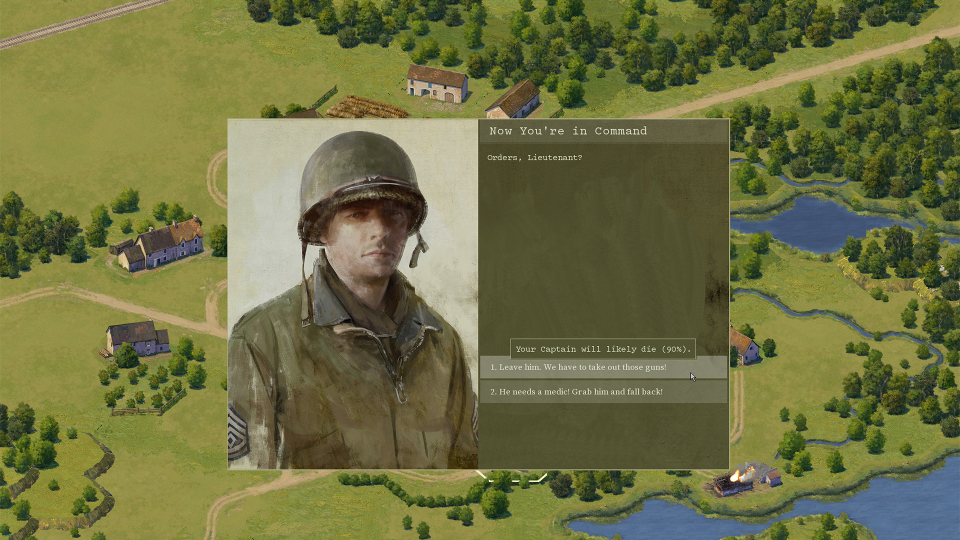
What is it then, that makes for a morally interesting decision in a video game? ”Put in front of the player several resources that they care about,” Luke replied, ”like their prestige, or their trust with the men, or casualties or not, or what their superior will think of them or what they will morally think of themselves, and then tie them to different decisions and don’t let you have all of them. Now you’re in a quandary.”
And it’s this that makes Burden of Command so intriguing. In its attempts to recreate the impossible decisions that a leader would have had to make – knowing full well that maybe there is no right choice and perhaps that every possible option is the wrong one. Will Burden of Command be successful in discovering how to make the concept of a psychological battlefield work as a video concept? I want to be at the front of the line to find out.
Partly listened to the Single Malt interview some time ago. Few tidbits (sorry don't recall much):
The campaign (about Cottonbalers, will start in Morocco, then Sicily, further in Italy, southern France, and Germany at the end) is linear, no branching story on that level, but we can choose if/how we do scenarios, even can decide to lose them. Some minor random events. Think there are four lieutenants and the first sergeant who report to the player. It's not only them who can disobey orders, however, but also the squad under their command can have its own doubts (sounds like two layers of trust, perhaps something like squad -> lieutenant -> player?). They'd like to hear suggestions for other campaigns. Will choose some for a DLC (am guessing this will depend on sales).
- Joined
- Apr 24, 2015
- Messages
- 19,231




ushas
Savant
- Joined
- Jan 5, 2015
- Messages
- 550
Seems it was the new blog entry. And some more game info is yet to come.
https://burdenofcommand.com/no-pushing-with-a-rope
Must admit, haven't heard about Grand Tactician: The Civil War game till now.
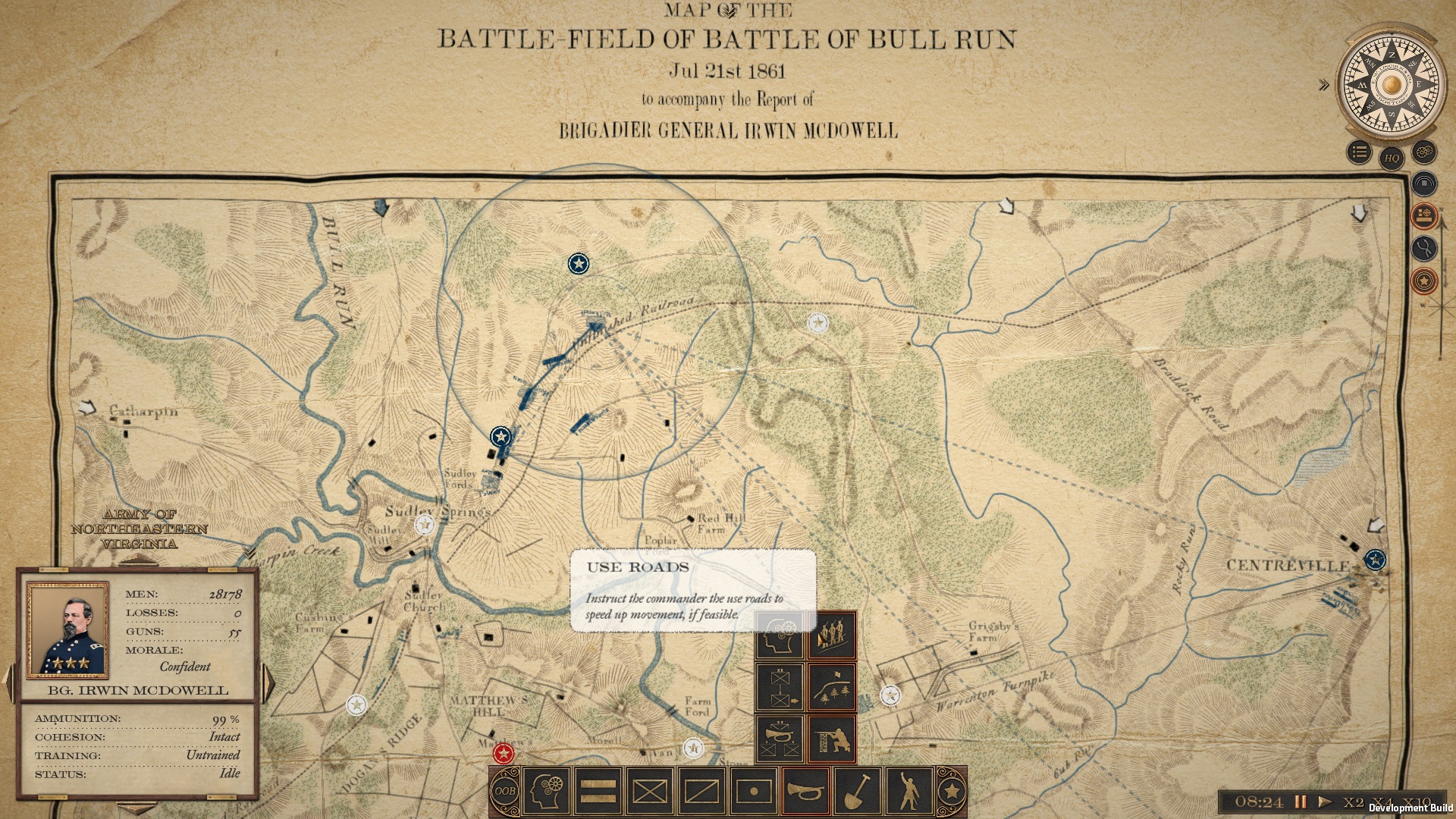
https://burdenofcommand.com/no-pushing-with-a-rope

Hello,
My name is Ilja Varha and I am an officer in the Finnish Defence Forces, a freelance game journalist and a game developer of Grand Tactician: The Civil War (1861-1865). I recently had a conversation with Luke about Burden of Command, an ambitious game project with unique focus on the challenges of commanding a company. I was very impressed with the game mechanics as described in the other dev blogs for BoC. Having commanded a company, Luke asked me to share some of my experiences in a form of a short essay, as they underline quite well how Burden of Command has grasped the reality of a company commander.
Infantry Company
An Infantry Company is a unique unit in the order of battle, as described in a sociological study by Knut Pipping.

A machinegun being maintained during a lull in fighting, Svir front, 1943. Image from SA-Kuva -archive.
My experiences fully agree with Mr. Pipping. In my experience, being a company commander, with around 100-200 subordinates, give or take, is the most demanding job for any young officer, and a true ordeal by fire for his leadership.
First of all, you (should!) know all the guys personally. And you are in the same shit with them 24 hours a day.
The company will form its own society, unlike the more abstract, from the point of view of the grunts, battalion. As the commander, there’s no escaping the needs of your men.
Second of all, you are already high enough in the hierarchy that you also start to feel the, sometimes unrealistic, expectations of your higher ups.
I like to describe the company commander being located in the narrowest point in an hourglass: below you got the troops and their needs, and overhead there is the pressure from battalion to accomplish the mission. Remembering that the sand flows only one way at a time! A bit like when you bow toward something, you are presenting your ass to something else, even if you don’t think it that way yourself. I could easily describe the situation as “burden of command”, and for this reason I really liked the game’s name and scope!
Responsibility
In Finland we have a conscript army, which means every officer, regardless of rank, will experience the life of a simple soldier during his conscription period. This is quite different to many professional armies, including most western ones. During my year in service I trained as a Jaeger Platoon (Finnish light infantry) leader. Later, after 4 years in Defence University and some training, I became a company commander in a mechanized brigade.
As a young platoon leader you have the company commander around to support you, or to kick you and your men forward, if needed. That’s because of the size of the company: you will still see the whole company with only small movement, and you are close enough to move to the platoon commander and support him face-to-face. Except in the new swarming doctrine, but that does not affect us in armor/mechanized branch.
When you go to battalion, things are very different again. Because of the size and number of men, you cannot be everywhere, and the responsibility to get stuff actually done, is with – surprise, surprise – the company commanders!
So at higher level, it’s more important to train the company commanders and give them good orders. You simply cannot supervise and support them all. And even if you have a better picture of the overall situation, you cannot push the same knowledge into the head of a company commander, as he will understand your orders and instructions according to what he sees at the grass level.
This became apparent when I was deployed with a company of Jaegers abroad, as a part of a multinational battalion. We were the boots on the ground, like always, and the higher ups were mostly tied to the camps, headquarters and other facilities. This meant that while I was thinking more about hills, roads, single people in towns in my Area of Responsibility and of course the threats to my soldiers, the guys giving me the orders were looking at tidy maps. And those two worlds seldom shook hands neatly.
The common experience, which is written in many books and films (Generation Kill), is that you are happy only with your own actions and maybe of those of your men, and the rest, especially above you, seem like a bunch of incompetent idiots running around aimlessly. This is because the different worlds are not shaking hands, and you feel as though you can reside only in one of them.
After a few months, I realized my job as the CO was very much in the narrow part of the hourglass. One of the most important things I had to do was to soften and filter the information and orders, and the occasional brainfarts, flowing through the organization from top down. Mostly so it would not hit the troops too hard – and therefore keep up their motivation. To be able to command the company I needed to live and breathe the single soldier’s life, so I could understand their needs and challenges in the mission better.
My responsibility was to be on the side of my men at the big tables, and to be out in the field at least as often as my Jaegers were. This was to teach the guys, to observe their actions and to make sure every soldier was doing things like I needed them to be done. I didn’t lead the patrols and small ops, but rather participated as a single soldier to see how my platoon commanders were doing things, and how the squad leaders managed. Then I talked to these guys in private about how they were doing, trying to boost their trust in themselves and in the mission. Of course, if something more serious happened, I would switch to CO mode and establish an ad-hoc command post to coordinate the overall situation.

A convoy preparing to move out with the Jaeger Company providing escort (2013).
Trust
That was a big learning experience to me: how to gain and build trust with the platoon commanders all the way down to single troops. This is something the player will be doing in Burden of Command. It’s very often I see, especially abroad, that the highest-ranking officer is present for even the most trivial details. I did not see it that way, but instead let my individual jaegers take charge of things and then supported them in the background. This noticeably helped their self-esteem and professional growth. And it also helped me learn to trust them – it’s a two-way street.
Another interesting detail, for me, was how to keep up the interest of guys, trained mainly in high intensity warfare, in a mission that was dull as hell, though with risks. How to keep them from getting passive in the “unbearable routine”? From their point of view, it was boring and nothing much happened on a daily basis. But when something did happen, you had to be able to anticipate the signs of the threat, and to react without delay.
The stunning tactical stunts, like the ones you are supposed to pull off in most computer games, are only a small part of being a leader. You are also a leader outside the “battlefield”. Another Finnish research from WW2 tells, that during the counter-attack phase of 1941, when basically the whole Finnish Army was taking back lost territories from Winter War, it was calculated that even the front-line soldier from the foremost fighting unit spent over 90% of the time without enemy contact. The troops are not just assets to accomplish your mission, like in games, but these are people you know. And if you do your job well, they trust your judgement when the time comes to carry out the orders with an uncertain outcome.
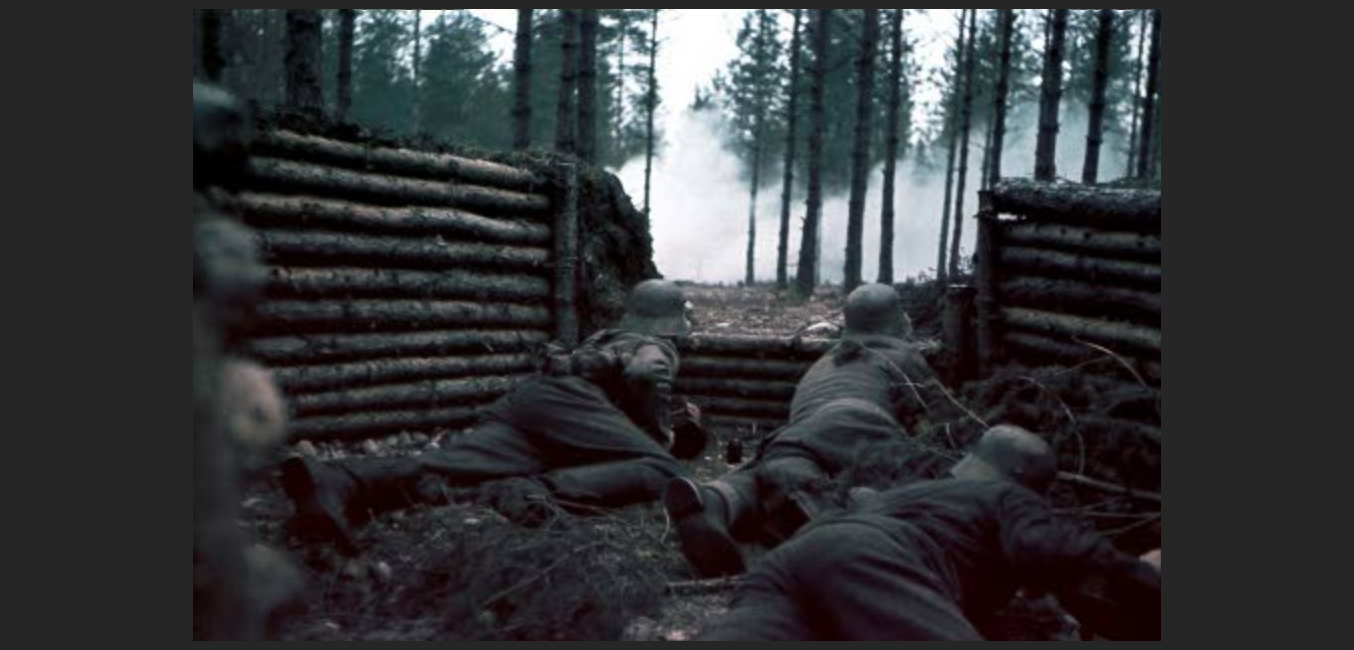
It’s the young soldiers doing the killing and dying. Troops preparing to fight in 1941. Image from SA-Kuva -archive.
Leadership
One interesting thing about the training I did with my mechanized company had to do with “leading from front, leading from further back” -problematics, or -mechanics, as implemented in Burden of Command -game. Let me give another metaphor I’ve grown fond of: “you cannot push with a rope“. This was something an older soldier taught me, after his experience of being hit by a VBIED and then getting his rattled troops to secure the area.
You can, and therefore must, pull! In Finland our contemporary military tradition is based greatly on the WW1 era German tradition. That’s where the rebellious Finns were trained before our country’s independence in 1917. And those same soldiers formed the corps of the higher command in WW2, and hence the spirit for the training we give today, as Finland remained independent after the war.
The tradition is to lead from the front. You don’t say “Go, move out!” Instead you are taught from the very beginning to say “Let’s go, follow me!” Some officers I’ve worked with have had hard time figuring out their physical location when commanding their troops. Usually commanders of today play the “better overall situational awareness” -card by staying back, eyes glued to the screens of their battlefield management systems and ears tuned to the radios. But when the attack stops, pushing will not work.

This company commander did not glue himself to modern command and control equipment. Lauri Törni was a Finnish shock force company commander, among other roles, during WW2. American readers will know him as Larry Thorne. The character Sven Kornie (John Wayne) in movie Green Berets is based on him.
What I learned was if you do this for long enough, you will completely alienate yourself from the men and their reality, and gain a certain, not so flattering, reputation. You’re on your way to becoming Captain America in Generation Kill, or Captain Sobel in Band of Brothers.
Here’s a clip from a 1955 Finnish war movie called “The Unknown Soldier”, (there are now three movie based on the book with the same title, second most sold in Finland, after The Bible). It shows something beautiful about leadership. The troops are in their first contact with a live enemy in 1941. They are all green except for the company commander (you will know him instantly) and one platoon commander (in charge of the MGs, and later the satchel charge).
Though it does not end well for everyone, the job gets done. That’s how I see the “burden of command”.
Morale
I learned from experience not to push with the rope. I noticed that commanders that coordinated movement from farther back, giving orders only by radio and coordinates on the map or BMS, were less likely to get their troops to maneuvers as intended. And why would they? The recipient of the order views the world between straws of hay while the sender has a digitized map-based perception of lines, symbols and arrows.
For me personally, the answer was to direct the men into combat with me, and when comfortably in contact at right place and time, I would step back a bit to observe the overall situation and to think of the next move. That meant showing the young lieutenants exactly where and how to go, face-to-face, and giving an example. By doing so, I would see every single soldier in my unit. And they would see me. The commander’s presence among the troops is more valuable than gold in many cases in regards to boosting morale. But the flip-side is the possibility of getting pinned down and be unable to lead – just like Burden of Command in question.
But the key is in training. The training never ends. No-one is ever completely ready. After a while I could ease up a bit, as I was certain they would execute any order I gave. This in my opinion is the key to “Auftragstaktik” or ‘Mission-type tactics’ as described by the Germans. Even if the commander is taken out, or out of reach, the unit would complete the mission according to commander’s will on its own.
As you can see, I am really hyped about Burden of Command, as it does so many things right, in a way not yet done in any computer wargames. I hope the best for the project, and also that many like-minded will find it and enjoy it once ready!
Burden of Command is currently in development by GreenTreeGames and slated for release in late 2019. You can follow its development through the following online resources (especially the dev blog):
www.burdenofcommand.com
https://store.steampowered.com/app/887490/Burden_of_Command/
https://www.facebook.com/burdenofcommand/
Ilja Varha is an officer in Finnish Defence Forces, a freelance game journalist and a game developer of Grand Tactician: The Civil War (1861-1865).
Grand Tactician: The Civil War (1861-1865) is a real time strategy game combining a strategic campaign with tactical battle game play. Run your nation, muster, manage and support great armies, and maneuver them to defeat the enemy. Once the opposing armies meet, command your troops to victory in battles fought on historical battlefields.
www.grandtactician.com
https://www.facebook.com/GrandTactician/
https://www.youtube.com/channel/UCInZ2dBg25tUrRYFuBWNODg/
https://store.steampowered.com/app/654890/Grand_Tactician_The_Civil_War_18611865/

Must admit, haven't heard about Grand Tactician: The Civil War game till now.

- Joined
- Apr 24, 2015
- Messages
- 19,231




Last edited by a moderator:
- Joined
- Apr 24, 2015
- Messages
- 19,231




Pacific campaign might be possible sequel.so will this have anime titties????
Maybe.
- Joined
- Apr 24, 2015
- Messages
- 19,231




- Joined
- Apr 24, 2015
- Messages
- 19,231




- Joined
- Apr 24, 2015
- Messages
- 19,231




- Joined
- Apr 24, 2015
- Messages
- 19,231




- Joined
- Apr 24, 2015
- Messages
- 19,231




- Joined
- Apr 24, 2015
- Messages
- 19,231





















